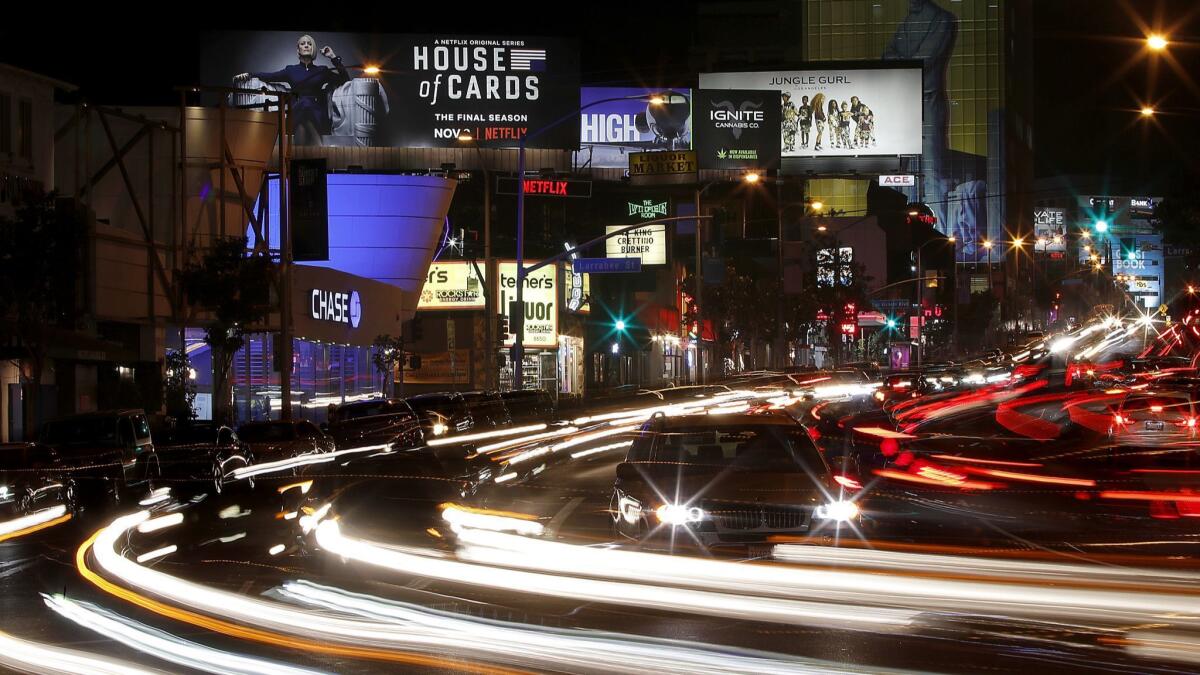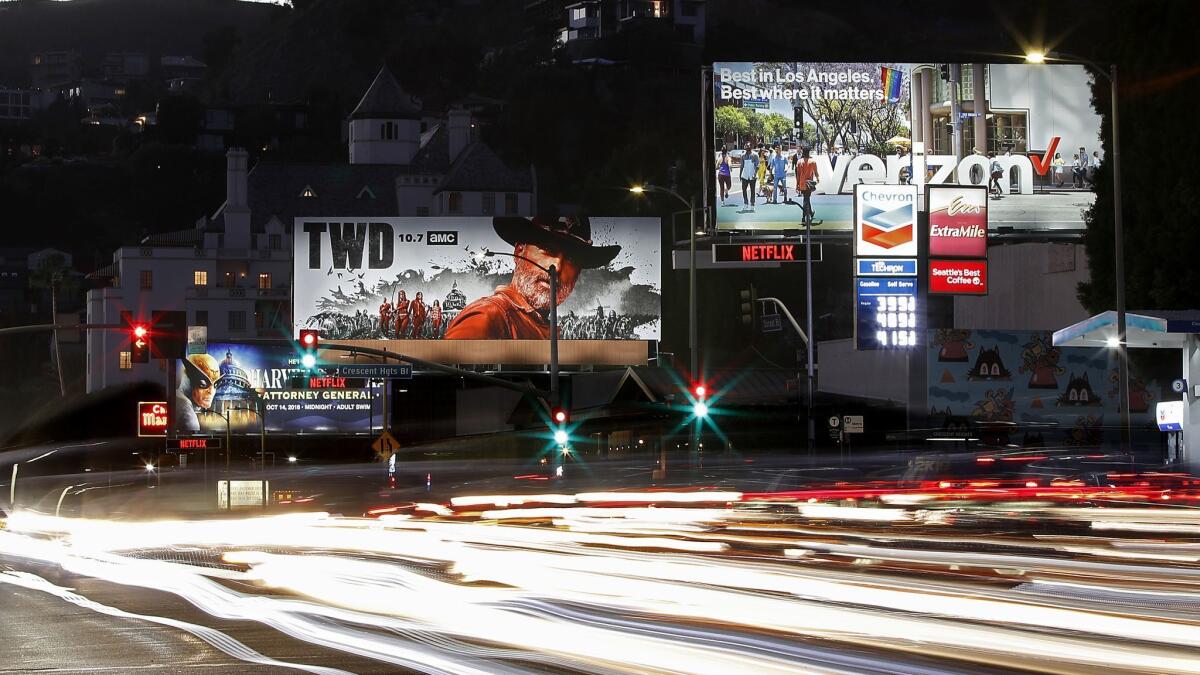Netflix’s latest conquest? Billboard advertising along the Sunset Strip

- Share via
Netflix is once again crashing the party to the chagrin of Hollywood studios, but this time in an old-school way — by acquiring billboards along the Sunset Strip.
The digital streaming Goliath has quietly bought up prime billboard space along the mile-and-a-half-long section of Sunset Boulevard in West Hollywood that is among the most coveted advertising properties in the country.
Along this winding stretch filled with tourists, the major studios and networks have historically promoted their latest titles with massive outdoor ads that tower over the street’s upscale shops and restaurants.
Netflix in recent months has purchased at least 18 billboard faces from Regency Outdoor Advertising, in a deal estimated to be worth tens of millions of dollars, according to ad industry insiders. The billboards, which are concentrated around Sunset Plaza and the Chateau Marmont, are already Netflix-branded, but some still carry ads for other studios and advertisers because of previous agreements with Regency.
Netflix is expected to eventually use the billboards to give its own TV shows and movies a big push. The streaming company is already promoting the final season of “House of Cards” on the newly acquired billboards, as well as the series “Daredevil,” “The Chilling Adventures of Sabrina” and the animated “Big Mouth.”
Netflix confirmed it has acquired an unspecified number of billboards in Los Angeles but declined to give further details. Regency didn’t respond to requests for comment. Reuters first reported in July that a potential deal was in the works.
The city of West Hollywood estimates that Regency owned about 50 billboard faces along the Strip, including each side of two-face billboards, according to a 2014 city survey.
A spokeswoman for West Hollywood said the city doesn’t have any information on the size of the deal or the purchase price.
Although the dollar amount of the acquisition is probably just a drop in the bucket for Netflix, which is expected to spend as much as $13 billion this year on content, the billboard play represents a significant symbolic move for the streaming company, signaling an investment in prestige marketing and aggressive awards campaigning.
The billboards will enhance Los Gatos, Calif.-based Netflix’s physical presence in L.A. The company established its local headquarters at Sunset Bronson Studios in Hollywood last year and is already expanding into a 13-story tower being constructed across the street.
Like almost everything Netflix does, the billboard purchase has riled up the competition — and not just in the entertainment industry. Local advertisers say the acquisition will decrease available billboard inventory and push up prices for a location that already commands top dollar.
“As an advertiser, it has really rained on the parade. It’s put a lot of upward pricing pressure on what’s left,” said Gino Sesto, founder of Dash Two, a Los Angeles-based digital and outdoor media buying agency. “This is the most prime, sought-after inventory in L.A.”
Billboard ads along the Strip have typically commanded prices at least twice those on any other street in Hollywood, according to local advertising agencies. Thanks to Netflix, those rental prices — which can be as much as $200,000 or more a month — have now risen by about 20% to 35%, they said.

That means other studios will probably shell out more money to promote their titles just as Oscar awards season is set to kick off. The Strip has historically been a favorite location for studios to place for-your-consideration billboard ads because of the large concentration of Academy voters and studio executives who live in the surrounding areas, such as the Hollywood Hills.
This year, Netflix has a serious Oscar contender in Alfonso Cuaron’s “Roma,” a Spanish-language drama that has earned raves and is set to premiere in December. It is also releasing the latest movies from the Coen brothers and actress Sandra Bullock. Next year, the company is expected to release films directed by Martin Scorsese and Steven Soderbergh, and a new miniseries from Ava DuVernay.
The billboards are Netflix’s latest way of signaling to the competition its growing level of industry clout and artistic prestige. “Netflix has a way of depositing just the right amount of sand in the bathing suits of studio heads. It’s very irritating,” said Tom Nunan, former president of NBC Studios and UPN, and now a lecturer at the UCLA School of Theater, Film and Television.
For studios, billboards along the Strip have traditionally served one purpose above all others: placating the egos of actors and directors.
“A lot of people don’t realize the degree to which these billboards are directed to the artists more than anyone else,” Nunan said.
As a studio executive, he said, “we would do everything we could to get billboards there primarily to make people feel good about working for us, to feel like they were being cared for.”
Netflix has faced frequent criticism that it doesn’t do enough to externally promote its original content, relying instead on its algorithms to suggest new titles on its browsing interface. Netflix titles don’t benefit from the kind of vast sums traditional studios spend each year to promote their shows.
“The most powerful promotion we have is the Netflix service itself,” Cindy Holland, the company’s head of original programming, said during a talk at the Television Critics Assn. media tour in Beverly Hills in July.
A lot of people don’t realize the degree to which these billboards are directed to the artists more than anyone else.
— Tom Nunan, former president of NBC Studios and UPN, and now a lecturer at UCLA
But as it aims to entice more major Hollywood talent away from competing studios, Netflix is looking to create an image of itself as a place where artistic creation is not only valued but visibly promoted. Billboards along the Strip are the most tangible part of that strategy.
“It’s intended to show your filmmakers the level of support you’re willing to commit to,” said one industry publicist who asked not to be named for fear of reprisals.
Netflix hasn’t entirely crowded out other studios from the popular thoroughfare. Walt Disney Co. still commands the biggest ad space along the Strip — the side of the 8560 Sunset Blvd. building, where the studio regularly promotes its latest big-screen releases, such as the upcoming “The Nutcracker and the Four Realms.”
The two biggest billboard owners along the Strip are Outfront Media and Clear Channel Outdoor, which still own the bulk of the street’s advertising inventory.
A spokeswoman for Outfront said that it hasn’t sold any billboards to Netflix and that the streaming company continues to advertise on its billboards in markets around the country. Some Outfront billboards on the Strip still carry Netflix ads. Clear Channel didn’t respond to a request for comment.
Though some forms of traditional advertising such as print have suffered major losses, the market for outdoor advertising appears to be holding steady and even rising slightly, with revenue up 1.2% in 2017 compared with the previous year, accounting for $7.7 billion in sales, according to the Outdoor Advertising Assn. of America.
Technology companies were three of the top 10 outdoor advertisers last year: Apple, Google and Amazon.
The association said Netflix ranked No. 11 among the largest outdoor advertisers last year, up from No. 28 in 2016 and No. 52 in 2015.
Tech firms like Netflix use billboard advertising as a real-world complement to digital marketing.
“You can’t miss it, you can’t change the page. That’s one of the appeals,” said Stephen Freitas, chief marketing officer at the Outdoor Advertising Assn. of America.
“Out-of-home [ads] drive people in the physical world to the online world, to people’s phones and devices.”
More to Read
Inside the business of entertainment
The Wide Shot brings you news, analysis and insights on everything from streaming wars to production — and what it all means for the future.
You may occasionally receive promotional content from the Los Angeles Times.











